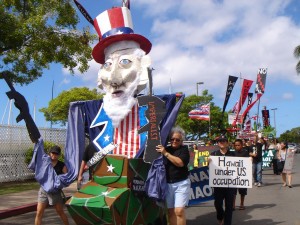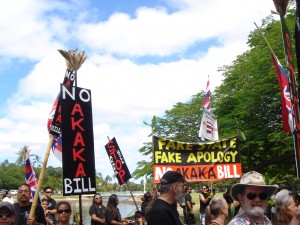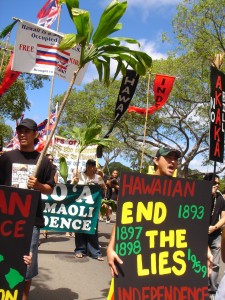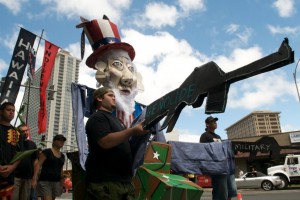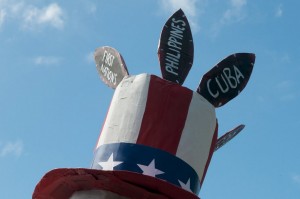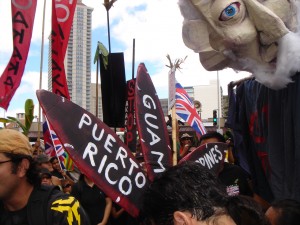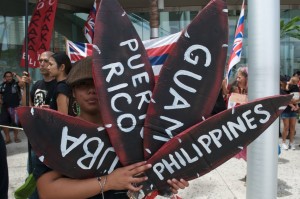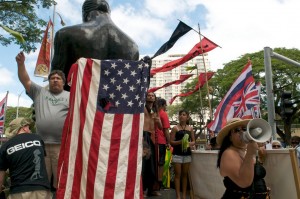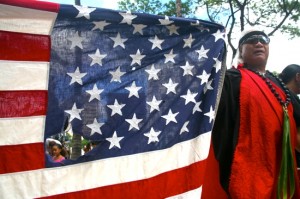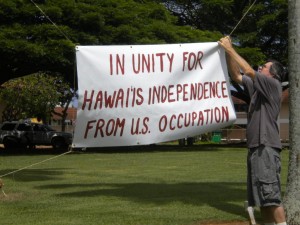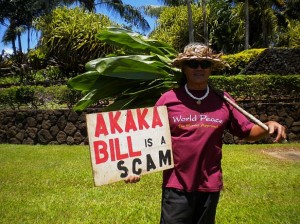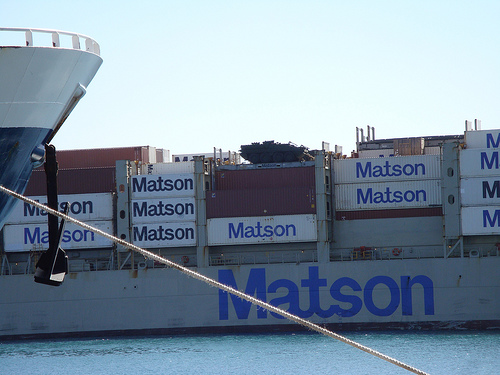Army desecration of burials angers Native Hawaiians
Yesterday, a representatives of Native Hawaiian organizations and other supporters went on a site visit to the area in Lihu’e (Schofield range) where the Army desecrated the burials of at least two individuals, including an adult and a child. Poi pounders and other cultural implements were also found at the site.
The Army’s propaganda spin machine has sought to make the desecration into “protection” and a cultural access into “consultation”. The Honolulu Advertiser article at bottom is inaccurate. It states that “All work was immediately halted.” But this is a false statement.
After the first bone was unearthed, the contract archeologist working for Garcia and Associates (GANDA) ordered the earth moving work to continue for another half-hour until more bones were found, in violation of federal and state laws that require all activity to cease when bones are unearthed.
The desecration of the sites in Lihu’e is happening on a massive scale. But since these areas are in live fire ranges and off limits to civilians, the destruction is largely invisible to the public. Below is the press release from Native Hawaiians who visited the site and performed ceremony for the ancestors that had been unearthed by the Army.
>><<
May 28, 2010
Hawaiian Community Angered by Desecration of Burials at Schofield Barracks
Lihuʻe, Oʻahu. Representatives from several organizations concerned over the U.S. Armyʻs recent disturbance of ʻiwi kupuna (ancestral remains) visited the site on Schofield Barracks where a cultural complex was disturbed by Stryker-related construction. They were told by Laurie Lucking, cultural resource manager for U.S. Army Garrison-Hawaii, that the area where the ʻiwi kupuna was unearthed would be “closed forever.” But military construction and training continue to destroy many other cultural sites in a large expanse of land sacred to native Hawaiians.
Leimaile Quitevis, former cultural monitor who documented many of the sites in Lihu’e and a member of the Oʻahu Island Burial Council comments on the significance of the cultural site complex. “Hundreds of archaeological site features have been identified in the immediate vicinity of Stryker Brigade construction. In addition, more than 300 surface artifacts were collected by Army representatives. The massive amount of cultural properties located in this area help to paint the picture of the pre-contact land use of Lihue. The significance and importance of this landscape to Kanaka Maoli is limitless. Lihuʻe was once the ruling center of Oʻahu, hosting famous rulers and infamous battles. This history is important when evaluating and assessing the historic properties that have been identified. These sites are not isolated ‘archaeological sites.’ They are features, pieces of a puzzle, and parts of a whole. These sites are part of a complex that laments and praises the history and culture of our ancestors. Several bone fragments have been documented throughout the project area. None of these bones have ever been positively identified by a qualified osteologist. In addition clusters of artifacts are treated as isolated finds rather than actual sites. To date this project has damaged numerous petroglyphs, desecrated a minimum of two individual’s graves and breached the site protective measures of Haleauau Heiau.”
“The Army failed to do adequate cultural site investigations and consultations before drawing up and proceeding with its Stryker brigade plans,” said Summer Mullins a representative from Kipuka, one of the three native Hawaiian groups involved in the 2004 litigation against Stryker expansion. This was the first time that she and many others were given access to the area once recognized as the seat of government for Oʻahu aliʻi. In the past, groups had made several requests for access that were ignored or denied by the Army.
She added, “This desecration was completely avoidable. It was not an ʻinadvertent discovery,’ as the Army claims. They need to be held responsible for their actions. The Army failed to listen to the strong concerns raised by cultural monitors and community members years ago about the cultural importance of the Lihu’e area. Our wahi pana and wahi kapu are not appropriate training areas.”
“When our Kanaka Maoli people say do not disturb an area but their advice is not heeded, this does not constitute ‘proactive dialogue.’ Desecration was predictable. We are faced with the problem that the Army occupies a vast area that physically retains important cultural sites and burial grounds. No matter what, access to these sites must be guaranteed to our kanaka maoli people. It is their traditional right to visit, care for and continue passing on history to the next generation,” said Terri Keko’olani of the American Friends Service Committee.
Representatives were angered by the Armyʻs initial claim that they were protecting the discovery, as their actions painted a completely different picture. “The assertion that ‘all work was immediately halted’ is false. The contract archaeologist for Garcia and Associates (GANDA) ordered digging and grading to continue after the first ʻiwi was found, a violation of Federal and State laws that call for all activity to cease. Earth moving activity stopped only after more bones were exposed,” added Leimaile Quitevis.
According to Tom Lenchanko, spokesperson for lineal descendants of the area, “The families object to any process where our human remains are damaged, with no sensitivity to the lands of our Lo Aliʻi – Lihuʻe, Wahiawa and Helemano encompassing over 35,000 acres that is Kukaniloko. This is our national treasure. Our kupuna are all over that aina, and the military is blatantly disrespecting our ancestral burial sites.”
“This is Hawaiian land, we all know that the US military has no moral or legal authority over our lands or resources,” said Andre Perez of Hui Pu. “Relocating the bones of our ancestors for warfare training is unacceptable. It is the military who needs to relocate.”
Noelani DeVincent, kumu hula and member of the Wahiawa Hawaiian Civic Club was heartbroken to see this sacred place ripped apart, “It was a really emotional experience to see such a huge wrong being done towards our people. It is our kuleana to right this wrong, but how can we trust the Army will take care of this place?”
Leimaile Quitevis added “Our kupuna are calling us to look to the lands of Lihuʻe. We must kukulu kumuhana (pull our strengths) and work together to defend the bones of our ancestors and the rich history of this ʻāina.”
Other participants in the cultural access include Kai Markell and Kamoa Quitevis of the Office of Hawaiian Affairs, William Aila of Hui Malama i Na Kupuna, Melva Aila of Hui Malama o Makua, and Kyle Kajihiro of the American Friends Service Committee.
Photo by Kai Markell at Lihu’e complex, Schofield Barracks. Many significant cultural sites are being destroyed by current Stryker-related construction.
Photo by Kai Markell at Lihuʻe complex, Schofield Barracks. Concerned Native Hawaiianʻs and community members inspect damage to cultural sites caused by Stryker-related construction.
####
Posted on: Friday, May 28, 2010
Army consults agencies on relocation of bones
Advertiser Staff
Army officials yesterday said they invited representatives from the State Historic Preservation Division, Office of Hawaiian Affairs, O’ahu Burial Council, ‘Ahu Kukaniloko and Hui Malama I Na Kupuna O Hawai’i Nei to visit a Schofield Barracks construction site where human remains were discovered earlier this month.
“Now that the remains have been found, the decision must be made whether the remains should stay where they were found, or whether they should be relocated to a more appropriate site where they would not be disturbed again,” Laurie Lucking, cultural resource manager for U.S. Army Garrison-Hawaii, said in a statement.
Lucking said the remains were found in an Army training area where military vehicles will be operating and performing exercises “and we are seeking recommendations from the representatives on this matter.”
The Army said it will publish a general notice to allow claimants an opportunity to consult with the Army on the final disposition of the remains once a decision is made on whether to move the remains from their location.
An Army-contracted cultural monitor from Garcia and Associates was on site when a single bone fragment was found on May 14 in a mound of earth that had recently been excavated. All work was immediately halted.
